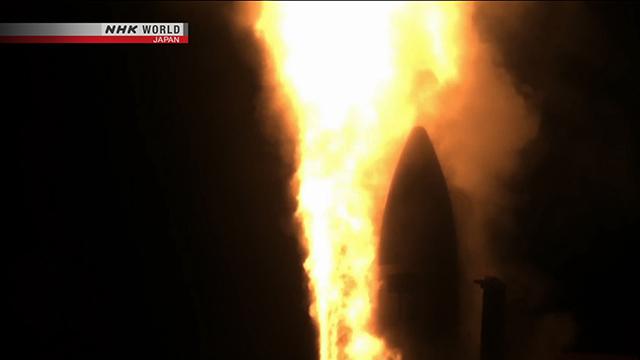On December 19th, Prime Minister Shinzo Abe's cabinet approved the installation of two Aegis Ashore ballistic missile defense batteries.
Japan already has a similar version of the missile interception system on its warships. Officials say the land-based system would cover all of Japan's territory. They hope to have them up and running by fiscal 2023.
Each system costs about an estimated 900 million dollars. They use a new type of missile interceptor jointly developed by Japan and the US.
Officials are looking into where to place the units. Two possibilities are Ground Self-Defense Force training fields in the west and north of the country.
But Japan's opposition parties are taking issue with the cost of the plan.
Tetsuro Fukuyama, the Constitutional Democratic Party Secretary-General, says "The Cabinet's plan does not mean we can address the North Korean situation immediately. In the budget talks, we have to ask the government whether this decision may have any impact on its other measures to counter threats from the North."
The announcement of the deployment marks the latest move by Japan to step up its defense capabilities.
Earlier this month, Japan's government said it is looking to install long-range cruise missiles on its fighter jets.
The opposition has taken issue with that decision, too. It argues that the plan could contradict the country's defense-only policy. They say the missiles could potentially be used to strike North Korea from Japanese airspace.
Pyongyang has tested a number of missiles this year, including 2 that passed over northern Japan. Last month, it launched what it claimed was a new type of ICBM capable of reaching anywhere on the US mainland.
Japan's current anti-ballistic missile defense systems
Japan currently relies on destroyers equipped with advanced Aegis radar systems and the land-based PAC3 system to intercept ballistic missiles.
If a missile is fired toward Japan, an Aegis destroyer in the Sea of Japan will use SM3 missiles to try and intercept it as it travels through space.
If this fails, the PAC3 system will then be used to try and shoot down the missile. Each system can cover a radius of twenty or thirty kilometers.
Reasons for the new deployment
North Korea's progress in ballistic missile technology has been a key factor behind Japan's decision to introduce Aegis Ashore.
The North has not only upgraded its ballistic missiles, it has also repeatedly launched them from mobile launchers and submarines, which are difficult to detect.
The country has also fired multiple missiles simultaneously, and launched them at lofted angles.
Experts say missiles fired at these angles are hard to intercept since they fall faster.
Japanese government officials say Aegis Ashore will make Japan's defenses better able to deal with the threat.
Officials plan to fit Aegis Ashore with a new type of interceptor missile, called SM3 Block IIA, which is being jointly developed by Japan and the US. It is an advanced version of the SM3 Block IA missiles that are on Aegis destroyers.
The new missiles will have a much longer range, which is why the government says 2 units can cover all of Japan.
Defense officials hope the land-based system will ease the burden of Self-Defense Force personnel on Aegis destroyers in the Sea of Japan.
Location, reliability, and cost concerns
One problem with the new system is that authorities still have to negotiate with the municipalities where they want it deployed.
Some are worried that the powerful electromagnetic waves emitted from the system's radar could affect people's health and aspects of daily life, including the use of cell phones and other electronic devices.
One person in Akita city says there is also a sense of anxiety that the city might now become a target.
Another issue is whether the new system will actually work.
An interceptor missile used on Aegis Ashore successfully shot down a target during a test in February. But it failed in a second test in June, making for a success rate of 50 percent.
Yet another problem is the budget. Currently, the cost of one Aegis Ashore system is estimated at just under 100 billion yen. But that may rise, depending on what radar system is used.
Former Maritime Self-Defense Force admiral Toshiyuki Itoh says it is inappropriate for the government to give in to all of the demands from the US regarding the Aegis defense system.
He says that since it means spending taxpayers' money, the government should first explain to the people each aspect of the deployment.
With the government already planning to introduce long-range cruise missiles on its fighter jets, the country's defense budget is drawing growing attention.
Russia criticizes Japan's plan
Senior Russian officials have been critical of Japan's plan to deploy the new land-based missile defense system.
Russian Deputy Foreign Minister Igor Morgulov said on December 19th that the decision would have a negative impact on Japan-Russia ties.
He said it would affect efforts to conclude a peace treaty between their two countries, which did not sign one after World War Two.
A senior Russian foreign ministry official in charge of disarmament, Mikhail Ulyanov, said the Aegis Ashore launch system is capable of using strike weapons, including cruise missiles.
He suggested that the deployment would violate the 1987 Intermediate-Range Nuclear Forces Treaty between the US and the Soviet Union. The INF treaty prohibits the deployment of ground-launched ballistic or cruise missiles with ranges of 500 to 5,500 kilometers.
Russia has accused the US of expanding its missile defense systems in Northeast Asia, and justifying it with threats from North Korea.
